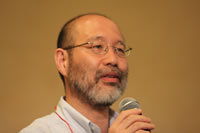The 17th International RUNX Workshop was held at The Oriental Hotel Hiroshima, Hiroshima City in Japan on July 11-14, 2010. The meeting was very successful, with about 100 attendees including 61 scientists from 12 overseas countries (Israel, France, Germany, United Kingdom, Scotland, USA, India, Thailand, Singapore, China, Taiwan and Korea).
The Runx gene family was identified in 1993 based on studies from multiple fields including virology, oncology and developmental biology. This brief history of discovery already indicates the variety and complexity of the biological functions of the Runx proteins, a situation that stimulated researchers in the field to set up a joint interdisciplinary Runx workshop. The 1st RUNX workshop was held in 1994, with just a few participating laboratories, and has been held annually since then. The International RUNX Workshop has become well recognized all over the world because of the rapid growth of this research area as well as a meeting spirit of sharing unpublished results, which has led to several epoch-making presentations at these workshops.
The International RUNX Workshop came back to Japan this year, for the first time since 2000, when Dr. Yoshiakai Ito, Kyoto University organized the 7th Runx workshop in Kyoto. Dr. Ichiro Taniuchi (photo 1) from RIKEN, Research Center for Allergy and Immunology, who is a president of The 17th International RUNX Workshop, selected Hiroshima as the meeting venue. Hiroshima suffered the disaster of the Atomic Bomb attack in 1945 and the people of Hiroshima have been afflicted with many diseases, mainly leukemias. Considering that one of the major topics in the Runx workshop was leukemogensis by Runx1/AML1 dysfunction, as well as in keeping with the contemporary international movement for the abolition of nuclear weapons, Dr. Taniuchi decided to have the meeting at Hiroshima. Indeed, almost all participants visited the Hiroshima Peace Memorial Museum during the meeting. The meeting program started with a talk by Dr. Yoshiaki Ito (photo 2), who is recognized as “a father of Runx” for his pioneering studies on the function of Runx3 in preventing gastrointestinal tract (GIT) epithelium carcinogenesis. Other topics discussed during the meeting included hematopoietic stem cell generation, lymphocyte development, bone and cartilage formation, neuronal development, and leukemogenesis. As in other fields, genome wide analyses incorporating novel technologies such as ‘omics’ studies, ChIP-sequence and RNAi library based screening, are widely used in the Runx field. Reflecting the close relationships that have developed among regular participants in this workshop, which has been ongoing for nearly two decades, many issues were deeply and, to some extent emotionally, discussed again in Hiroshima. Historically, this workshop has highlighted different model organisms, from C. elegans, Drosophila, all the way to mouse.This year, the octopus was shown by a chairperson of the model animal session (photo 3), but it soon turned out to be an expression of sympathy for two disappointed attendees from the Netherlands. The final of the FIFA World Cup, in which Spain defeated the Netherlands after extra time, fell on the second day of the workshop and the octopus on the screen was the world-renowned psychic octopus Paul, who successfully predicted the winners of multiple soccer matches.
The 18th international RUNX Workshop will be held next in San Diego, USA.



